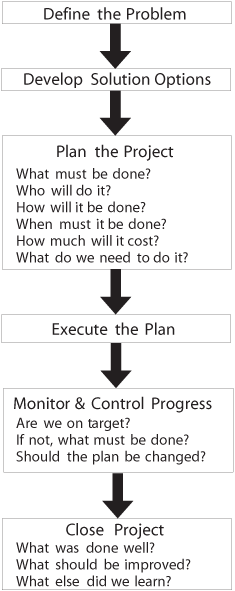The Steps in Managing a Project
The actual steps to manage a project are straightforward. Accomplishing them may not be. The model in Figure 1-4 illustrates the steps.
Figure 1-4. The steps in managing a project.

Subsequent chapters of this book will elaborate on how each step is accomplished. For now, here is a brief description of the actions involved.
Define the Problem
As was discussed previously, you need to identify the problem to be solved by the project. It helps to visualize the desired end result. What will be different? What will you see, hear, taste, touch, or smell? (Use sensory evidence if things can’t be quantified.) What client need is being satisfied by the project?
Develop Solution Options
How many different ways might you go about solving the problem? Brainstorm solution alternatives (you can do this alone or as a group). Of the available alternatives, which do you think will best solve the problem? Is it more or less costly than other suitable choices? Will it result in a complete or only a partial fix?
Plan the Project
Planning is answering questions. What must be done, by whom, for how much, how, when, and so on. Naturally, answering these questions often requires a crystal ball. We will discuss these steps in more detail in chapters two through four.
Execute the Plan
Obvious. Once the plan is drafted, it must be implemented. Interestingly, we sometimes find people going to great effort to put together a plan, then failing to follow it. If a plan is not followed, there is not much point in planning, is there?
Monitor and Control Progress
Plans are developed so that you can achieve your end result successfully. Unless progress is monitored, you cannot be sure you will succeed. It would be like having a roadmap to a destination, but not monitoring the highway signs.
Of course, if a deviation from the plan is discovered, you must ask what must be done to get back on track, or—if that seems impossible—how should the plan be modified to reflect new realities?
Close the Project
Once the destination has been reached, the project is finished, but there is a final step that should be taken. Some people call it an audit, others a post-mortem (sounds a bit morbid, doesn’t it?). Whatever you call it, the point is to learn something from what you just did. Note the way the questions are phrased: What was done well? What should be improved? What else did we learn? We can always improve on what we have done. However, asking What did we do wrong? is likely to make people a bit defensive, so the focus should be on improvement, not on placing blame. More on this later.
